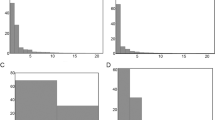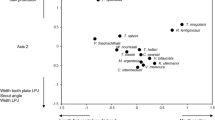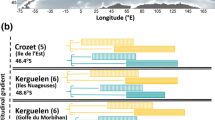Abstract
Although niche partitioning is distinctly difficult to be quantitatively measured, the fossil record can provide the necessary archive for detecting and measuring niche differentiation at different spatial and temporal scales. The consequences of the evolution of the durophagous predators in the Mesozoic Era are well documented among many invertebrates such as mollusks and brachiopods. However, they are less characterized among the echinoderms. In order to assess the consequence of increased predation on the echinoderms and to find the causality between their diversity/dispersion and the sea level variations, the echinoderm occurrence data from the Paleobiology Database was spatiotemporally analyzed. The results indicated that life habit, diet, and locomotion of the echinoderm communities have undergone a major shift. Indeed, a steady trend of increasing the mobile and infaunal taxa, which is a well-known predator-resistant life mode, was observed. In addition, a significant positive correlation was found between carnivores and both of mobile and infaunal taxa (R = 0.70 and 0.56 respectively, p < 0.001), which indicates that mobility and infaunalization provide the opportunity to avoid predation. Moreover, there was a temporal shift in the latitudinal diversity gradient where the diversity peak occurs mainly between 10 and 40 N. Furthermore, there is a general concordance between the echinoderm diversity and the Mesozoic sea level curve. Cluster analyses and nonmetric multidimensional scaling (nMDS) indicated that with increasing sea level, the fauna which was distinct among the different geographic provinces in the Triassic became more similar during the Cretaceous. The latter suggests that sea level is a major factor controlling the biogeographic pattern of the benthic invertebrates.










Similar content being viewed by others
References
Abdelhady AA (2008) Cenomanian/Turonian mass extinction of macroinvertebrates in the context of paleoecology. A case study from north Wadi Qena, Eastern Desert, Egypt. In: Elewa AMT (ed) Mass extinction - the danger around us. Springer Verlag, Heidelberg/Berlin, pp 103–127. https://doi.org/10.1007/978e3e540e75916e4_9
Abdelhady AA (2016) Phenotypic differentiation of the Red Sea gastropods in response to the environmental deterioration: geometric morphometric approach. J Afr Earth Sci 115:191–202. https://doi.org/10.1016/j.jafrearsci.2015.12.001
Abdelhady AA, Abdalla MM (2018) Categorization models as a powerful tool in paleontological data analyses – the Phanerozoic bivalves. Biodiversitas 19:1769–1776. https://doi.org/10.13057/biodiv/d190525
Abdelhady, A.A., Elewa, A.M.T., 2010. Evolution of the upper Cretaceous oyster. A traditional morphometric approaches. In: Elewa, A.MT (Ed.), Morphometrics for non morphmetricians. Springer Verlag, Berlin/Heidelberg, pp. 157e175. https://doi.org/10.1007/978e3e540e95853e6_6
Abdelhady AA, Fürsich FT (2014) Macroinvertebrate palaeo–communities from the Jurassic succession of Gebel Maghara (Sinai, Egypt). J Afr Earth Sci 97:173–193
Abdelhady AA, Fürsich FT (2015a) Sequence architecture of a Jurassic ramp succession from Gebel Maghara (North Sinai, Egypt): implications for eustasy. J Palaeogeogr 4:305–330
Abdelhady AA, Fürsich FT (2015b) Palaeobiogeography of the Bajocian–Oxfordian macrofauna of Gebel Maghara (North Sinai, Egypt): implications for eustacy and basin topography. Palaeogeogr Palaeoclimatol Palaeoecol 417:261–273
Abdelhady AA, Mohamed RSA (2017) Paucispecific macroinvertebrate communities in the Upper Cretaceous of El Hassana Dome (Abu Roash, Egypt): environmental controls vs adaptive strategies. Cretac Res 74:120–136. https://doi.org/10.1016/j.cretres.2017.02.014
Abdelhady AA, Seuss E-DMH, Obaidalla NH, Mahfouz AK, Hussien SAA (2018a) The unitary association method in biochronology and its potential stratigraphic resolving power: a case study from Paleocene-Eocene strata of southern Egypt. Geobios 51(4):259–268
Abdelhady AA, Abdelrahman E, Elewa AMT, Fan J, Zhang S, Xiao J (2018b) Phenotypic plasticity of the gastropod Melanoides tuberculata: a pollution-induced stabilizing selection. Mar Pollut Bull 133:701–710. https://doi.org/10.1016/j.marpolbul.2018.06.026
Abdelhady AA, Khalil M, Ismail E, Mohamed R, Ali A, Snousy M, Fan D, Zhang S, Xiao J (2019a) Potential biodiversity threats associated with the metal pollution in the Nile-Delta ecosystem (Manzala lagoon, Egypt). Ecol Indic 98:844–853. https://doi.org/10.1016/j.ecolind.2018.12.002
Abdelhady AA, Khalil M, Ismail E, Fan D, Zhang S, Xiao J (2019b) Water chemistry and substrate type as major determinants for molluscan feeding habit and life-mode in lagoon sediments. Estuar Coast Shelf Sci 220:120–130. https://doi.org/10.1016/j.ecss.2019.02.019
Abdelhady AA, Mohamed R, Fathy D, Ali A (2020) Benthic invertebrate communities as a function of sea-level fluctuations and hydrodynamics: a case from the Cenomanian-Turonian of Wadi Tarfa (Eastern Desert, Egypt). J Afr Earth Sci 168:103870. https://doi.org/10.1016/j.jafrearsci.2020
Abdel-Raheem KHM, Ali MSM, Azab MM, Abdelhady AA (2020) Paleoecology and paleobiogeography of the Cenomanian-Turonian bivalves from the Southern Galala Plateau (Eastern Desert, Egypt). J Afr Earth Sci 103873. https://doi.org/10.1016/j.jafrearsci.2020.103873
Alberti M, Fürsich FT, Abdelhady AA, Andersen N (2017) Middle to Late Jurassic equatorial seawater temperatures and latitudinal temperature gradients based on stable isotopes of brachiopods and oysters from Gebel Maghara, Egypt. Palaeogeogr Palaeoclimatol Palaeoecol. https://doi.org/10.1016/j.palaeo.2016.11.052
Alroy J (2008) Dynamics of origination and extinction in the marine fossil record. – Proc. Natl Acad. Sci. USA 105:11536–11542
Alroy J, Marshall CR, Bambach RK, Bezusko K, Foote M, Fursich FT, Hansen TA, Holland SM, Ivany LC, Jablonski D, Jacobs DK, Jones DC, Kosnik MA, Lidgard S, Low S, Miller AI, Novack-Gottshall PM, Olszewski TD, Patzkowsky ME, Raup DM, Roy K, Sepkoski JJ, Sommers MG, Wagner PJ, Webber A (2001) Effects of sampling standardization on estimates of Phanerozoic marine diversification. Proc Natl Acad Sci 98:6261–6266
Ayoub-Hannaa WS, Abdelhady AA, Fürsich FT (2017) Costinuculana magharensis n. gen. n. sp. (Bivalvia, Nuculanidae) from the Middle Jurassic of Gebel Maghara, North Sinai, Egypt. J Paleontol 91(3):434–443. https://doi.org/10.1017/jpa.2016.161
Barnes R (1987) Invertebrate zoology. Dryden Press, Orlando 893 p
Baumiller TK, Gahn FJ (2013) Reconstructing predation pressure on crinoids: estimating arm-loss rates from regenerating arms. Paleobiology 39(1):40–51
Baumiller TK, Mooi RM, Charles G (2008) Urchins in the meadow: paleobiological and evolutionary implications of cidaroid predation on crinoids. Paleobiology 34(1):22–34
Baumiller T, Salamon M, Gorzelak P, Mooi R, Messing C, Gahn F (2010) Post-Paleozoic crinoid radiation in response to benthic predation preceded the Mesozoic marine revolution. Proc Natl Acad Sci 107(13):5893–5896
Borszcz T, Zatoń M (2013) The oldest record of predation on echinoids: evidence from the M. Jurassic of Poland. Lethaia 46:141–145
Boucot AJ (1975) Evolution and extinction rate controls. Elsevier, Amsterdam
Díaz S, Fargione J, Chapin FS, Tilman D (2006) Biodiversity loss threatens human well-being. PLoS Biol 4:e27
Dietl G, Kelley P (2002) The fossil record of predator-prey arms races: coevolution and escalation hypotheses. Paleontological Society Papers 8:353–374
Du H, Bao Z, Hou R, Wang S, Su H et al (2012) Transcriptome sequencing and characterization for the sea cucumber Apostichopus japonicus (Selenka, 1867). PLoS One 7(3):333–311
Elewa AMT, Abdelhady AA (2020) Past, present, and future mass extinctions. J Afr Earth Sci 164:103780. https://doi.org/10.1016/j.jafrearsci.2019.103678
Finnegan S, McClain C, Kosnik M, Payne J (2011) Escargots through time: an energetic comparison of marine gastropod assemblages before and after the Mesozoic marine revolution. Paleobiology 37(2):252–269
Foote M (2000) Origination and extinction components of taxonomic diversity: general problems. Paleobiology 36:72–102
Foote M (2014) Environmental controls on geographic range size in marine animal genera. Paleobiology 40(3):440–458
Gorzelak P (2018) Microstructural evidence for stalk autotomy in Holocrinus – the oldest stem-group isocrinid Palaeogeography, Palaeoclimatology, Palaeoecology. 506:202–207
Gorzelak P, Salamon MA, Baumiller TK (2012) Predator-induced macroevolutionary trends in Mesozoic crinoids. Proc Natl Acad Sci U S A 109(18):7004–7007
Gorzelak P, Salamon MA, Trzęsiok D, Lach R, Baumiller TK (2016) Diversity dynamics of post-Palaeozoic crinoids - in quest of the factors affecting crinoid macroevolution. Lethaia 49(2):231–244
Gould SJ (1988) Trends as changes in variance: a new slant on progress and directionality in evolution. J Paleontol 62:319–329
Groth P, Frew J, Santos E, Koop D, Maxwell T, Doutriaux C, Ellqvist T, Potter G, Freire J, Williams D, Silva C (2012) Designing a provenance-based climate data analysis application. In: Provenance and Annotation of Data and Processes, vol 7525. Springer, Berlin Heidelberg, pp 214–219. https://doi.org/10.1016/j.geobios.2018.06.005
Guensburg TE, Sprinkle J (1992) Rise of echinoderms in the Paleozoic evolutionary fauna: significance of paleoenvironmental controls. Geology 20:407–410
Hammer Ø, Harper DAT, Ryan PD (2001) PAST: paleontological statistics software package for education and data analysis. Palaeontol Electron 4:1–9
Haq BU, Hardenbol J, Vail PR (1987) The chronology of the fluctuating sea level since the Triassic. Science 235:1156–1167
Harnik PG, Jablonski D, Krug AZ, Valentine JW (2010) Genus age, provincialarea, the taxonomic structure of marine faunas. Proc R Soc B Biol Sci 277:3427–3435
Harper E, Skelton P (1993) The Mesozoic marine revolution and epifaunal bivalves. Scr Geol 2:127–153
Hofmann R, Hautmann M, Wasmer M, Bucher H (2013) Palaeoecology of the Spathian virgin formation (Utah, USA) and its implications for the early Triassic recovery. Acta Palaeontol Pol 58:149–173
Jain S, Abdelhady AA, Alhussein M (2019) Responses of benthic foraminifera to the environmental variability: a case from the Middle Jurassic Kachchh Basin (Western India). Mar Micropaleontol 151:101749. https://doi.org/10.1016/j.marmicro.2019.101749
Jain S, Niazi M, Abdelhady AA, Vahidinia M, Hossein M (2020) The Campanian paleoenvironment: inferences based on benthic foraminifera from northeastern Iran. Palaeogeogr Palaeoclimatol Palaeoecol 554:109823. https://doi.org/10.1016/j.palaeo.2020.109823
Kerr JP, Kelley PH (2015) Assessing the influence of escalation during the Mesozoic marine revolution: shell breakage and adaptation against enemies in Mesozoic ammonites. Palaeogeogr Palaeoclimatol Palaeoecol 440:632–646
Klompmaker AA, Schweitzer CE, Feldmann RM, Kowalewski M (2013) The influence of reefs on the rise of Mesozoic marine crustaceans. Geology 41(11):1179–1182
Knoll AH, Follows MJ (2016) A bottom-up perspective on ecosystem change in Mesozoic oceans. Proc R Soc B Biol Sci 283:20161755
Marshal DJ, Abdelhady AA, Teck Wah TD, Mustapha N, Gӧdeke SH, De Silva LC, Hall-Spencer JM (2019) Biomonitoring acidification using marine gastropods. Sci Total Environ 692:833–843. https://doi.org/10.1016/j.scitotenv.2019.07.041
Miller KG, Kominz MA, Browning JV, Wright JD (2005) The Phanerozoic record of global sea-level change. Science 310(5752):1293–1298
Mora C, Sale P (2011) Ongoing global biodiversity loss and the need to move beyond protected areas: a review of the technical and practical shortcomings of protected areas on land and sea. Mar Ecol Prog Ser 434:251–266
Nürnberg S, Aberhan M (2013) Habitat breadth and geographic range predict diversity dynamics in marine Mesozoic bivalves. Paleobiology 39(3):360–372
Polly, P.D., 2014a. Phylogenetics for Mathematica. Version 3.0. Department of Geological Sciences, Indiana University: Bloomington, Indiana
Polly PD (2014b) Quantitative Paleontology for Mathematica. Version 4.1. Department of Geological Sciences, Indiana University, Bloomington
Polly PD (2014c) Geometric morphometrics for Mathematica. Version 11.0. Department of Geological Sciences, Indiana University, Bloomington
Roy K (1994) Effects of the Mesozoic marine revolution on the taxonomic, morphologic, and biogeographic evolution of a group: aporrhaid gastropods during the Mesozoic. Paleobiology 20(3):274–296
Roy K, Jablonski D, Valentine JW, Rosenberg G (1998) Marine latitudinal diversity gradients: tests of causal hypotheses. Proc Natl Acad Sci 95:3699–3702
Ruban DA (2010) Do new reconstructions clarify the relationships between the Phanerozoic diversity dynamics of marine invertebrates and long-term eustatic trends? Ann Paléontol 96:51–59
Ruppert EE, Fox RS, Barnes RD (2004) Invertebrate zoology, 7th edn. Cengage Learning, Boston
Salamon MA, Niedzwiedzki R, Gorzelak D, Lach R, Surmik D (2012) Bromalites from the middle Triassic of Poland and the rise of the Mesozoic marine revolution. Palaeogeogr Palaeoclimatol Palaeoecol 321:142–150
Signor PW, Brett CE (1984) The mid-Paleozoic precursor to the Mesozoic marine revolution. Paleobiology 10:229–245
Slater GJ, Harmon LJ (2013) Unifying fossils and phylogenies for comparative analyses of diversification and trait evolution. Methods Ecol Evol 4:699–702
Smith AB, McGowan AJ (2007) The shape of the Phanerozoic marine palaeodiversity curve: how much can be predicted from the sedimentary rock record of Western Europe? Palaeontology 50:765–774
Smith AB, Monks NEA, Gale AS (2006) Echinoid distribution and sequence stratigraphy in the Cenomanian (Upper Cretaceous) of southern England. Proc Geol Assoc 117:207–217
Sorenson L, Santini F, Alfaro ME (2014) The effect of habitat on modern shark diversification. J Evol Biol 27(8):1536–1548
Sørensen AM, Surlyk F, Jagt JWM (2012) Adaptive morphologies and guild structure in a high-diversity bivalve fauna from an early Campanian rocky shore, Ivö Klack (Sweden). Cretac Res 33:21–41
Stanley SM (1973) An explanation for Cope's rule. Evolution 27:1–26
Stevenson A, Gahn FJ, Baumiller TK, Sevastopulo GD (2017) Predation on feather stars by regular echinoids as evidenced by laboratory and field observations and its paleobiological implications. Paleobiology 43(2):274–285
Stöhr S, O'Hara TD, Thuy B (2012) Global diversity of brittle stars (Echinodermata: Ophiuroidea). PLoS One 7(3):e31940
Tomašových A, Kidwell SM (2009) Preservation of spatial and environmental gradients by death assemblages. Paleobiology 35:122–148
Varela S, González-Hernández J, Sgarbi LF, Marshall C, Uhen MD, Peters S, McClennen M (2015) paleobioDB: an R package for downloading, visualizing and processing data from the Paleobiology database. Ecography 38:419–425
Vermeij GJ (1977) The Mesozoic marine revolution: evidence from snails, predators and grazers. Palaeobiology 3:245–258
Vermeij GJ (1994) The evolutionary interaction among species: selection, escalation, and coevolution. Annu Rev Ecol Syst 25:219–236
Walker S, Brett C (2002) Post-Paleozoic patterns in marine predation: was there a Mesozoic and Cenozoic marine revolution? Paleontol Soc Pap 8:119–194
Acknowledgments
Two anonymous reviewers are acknowledged for their constructive comments. This contribution is based on data from the Paleobiology Database (http://paleobiodb.org/#/); therefore, we acknowledge all of the contributors to this database (e.g., Wolfgang Kiessling, Loic Villier, Franz Fürsich, Mark Patzkowsky, and Andrew Smith). This is PBDB official publication #376.
Funding
This work was supported by the Deutsche Gesellschaft für Internationale Zusammenarbeit (GIZ) GmbH/Centre for International Migration and Development (CIM), Germany (grant number 41704).
Author information
Authors and Affiliations
Corresponding author
Additional information
This article is part of the Topical Collection on New Advances and Research Results on the Geology of Africa.
Rights and permissions
About this article
Cite this article
Abdelhady, A.A., Elshekhipy, A.A. Niche partitioning among the Mesozoic echinoderms: biotic vs abiotic traits. Arab J Geosci 13, 882 (2020). https://doi.org/10.1007/s12517-020-05908-4
Received:
Accepted:
Published:
DOI: https://doi.org/10.1007/s12517-020-05908-4




